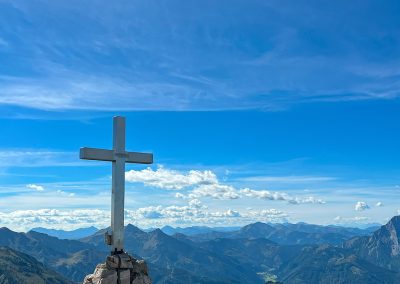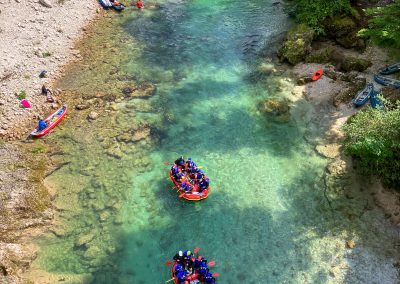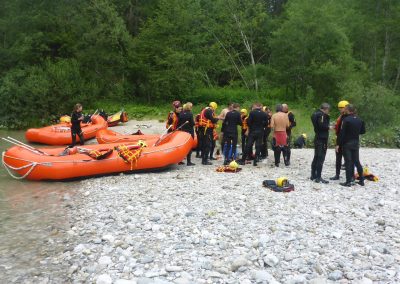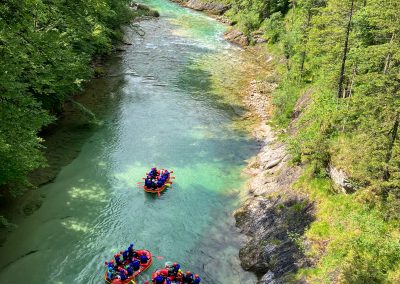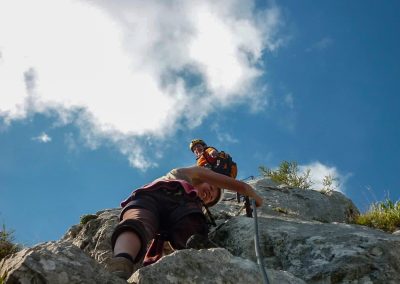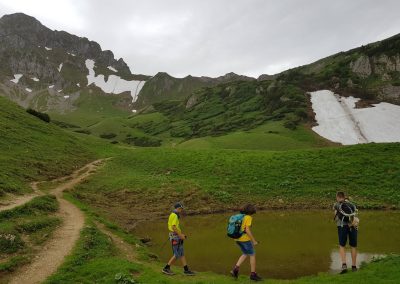Program options:
Via Ferrata, Klettersteig
What does this initially odd-sounding term mean?
"The Via Ferrata (meaning 'iron road' in Italian; 'klettersteig' in German) is a mountain route equipped with ladders, steps, bridges, and metal cables to aid progress. Via Ferrata hiking requires some practice, physical fitness, and appropriate equipment. Since these routes often lead to great heights, overcoming vertigo is an essential part of such tours." (Source: Wikipedia)
In essence, it's an extreme sport with a history of over a century, blending aspects of high-altitude trekking and rock climbing into a distinct discipline. Over time, it has evolved into a fully-fledged pursuit of its own, offering both safety and unforgettable experiences to those who dare to try it. Initially, it attracts primarily mountain enthusiasts curious to explore this sport. Unlike regular trekking, it involves some specialized gear, though not to the complexity or expense of, say, alpinism or rafting equipment.
Essentially, classic ferrata routes are old, well-established climbing paths constructed by professional mountaineers. Their aim was to allow people, assuming a certain level of climbing knowledge, to marvel at unique cultural and natural attractions without the need for extensive gear or advanced rock climbing skills typically required to access such areas without such protection.
Difficulty levels
The classification follows an A-E scale, which corresponds to the UIAA rock climbing difficulty grades without the use of safety ropes, in a certain order.
A,B – Easy grades, the main difficulty lies in continuous clipping
C – Enjoyable sections begin here
D – Requires significant muscle work but can be managed by regular climbers
E – Requires good fitness; attempt it after successfully completing D-rated routes.
Usually, the entire route is given the grade corresponding to its hardest section. For example, Haidsteig is rated as D, although it has only one 15-meter section of this difficulty. Before starting, it's advisable to gather information because a route with a 150-meter D section is not the same as one with a 15-meter D section. Serious via ferratas typically start with a challenging section where less experienced climbers may struggle, avoiding congestion further up.
(Source: http://lud.trek.tripod.com/vegyes/viaferrata.htm)
Nearby, you can access the following routes among the recently built modern klettersteigs in the area:
The Lying Priest – "Eisenerzer Klettersteig" on Pfaffenstein
http://www.hegyvilag.hu/wp-content/uploads/2009/02/eisenerzer-map.pdf
The Emperor Himself – "Kaiser Franz Josef Klettersteig"
http://www.turatars.com/blog/view/id_594/title_A-Csaszar-maga-Kaiser-Franz-Joseph
As if it were two tours – "Rosslochhöhlen Klettersteig"
https://www.steiermark.com/de/Urlaub-planen/Tourenportal/Rosslochhoehlen-Klettersteig_tour_1143811
Shield – "Kaiserschild Klettersteig"
http://www.hegyvilag.hu/?p=2023
Useful links:
http://www.klettersteige-eisenerz.at/klettersteige_wandern.htm
Cycling tours
Austria, familiar for its ski slopes, boasts a professional cycling infrastructure with well-developed, signposted cycling routes. In Styria province alone, there are thousands(!) of kilometers of bike paths. It's not a coincidence, as local active skiers also hop on their bikes during the spring, summer, and autumn months, keeping their skiing muscles in top condition.
It can be said that Austria is a true cyclist's paradise, and the mountains surrounding Präbichl offer numerous designated cycling routes. Just 200 meters from the guesthouse lies one of the mountain bike trails, stretching 14 km with a 389 m elevation gain, classified as moderately difficult. There are many other cycling routes in the area suitable for beginners as well as seasoned cyclists.
https://hu.bergfex.com/sommer/praebichl/touren/bike/
Among the countless options, everyone can find enjoyable routes, and for the most determined, there may be tougher rides than the Mátra marathon.
The pyramid-shaped open-pit mine, located 2 km from the guesthouse, is a paradise for professional and amateur mountain bike racers and motocross enthusiasts in the summer, hosting numerous cycling competitions.
Paragliding
"If once you have tasted flight, you will forever walk the earth with your eyes turned skyward, for there you have been, and there you will always long to return, to the clouds..." Leonardo Da Vinci
For the Hungarian sports and nature enthusiasts hoping to find the sensation of freedom in paragliding, neither the erratic legislation nor the various conditions (human, societal, communal, financial, commercial, etc.) of this extreme sport in the country have dampened their spirits. They can already sense the physical reality of the Hungarian lowland.
This can be viewed from a positive perspective because based on personal experience, I can confidently say that the average Hungarian paraglider is significantly more skilled in takeoff techniques and has better physical endurance than their counterparts from mountainous countries, making both factors undeniable strengths of this domestic sport.
Furthermore, locations like Nyikom, Eger, and Bérhegy offer suitable sporting opportunities. Moreover, squabbling with local conservationists in the Pilis or Csobáncon is actually a logical continuation of the Hungarian bandit life from the early 20th century.
Then, the first Hungarian magazine, the "Ernyősök," appears, and we read bombastic reports about paragliding - exclusively (!) abroad... And our big shots and aspiring big shots start flocking to Austria and Slovakia one after another. So, there must be something that attracts the boys and girls raised on the tow rope beyond the edge of the cliff!
As an introduction (and to kick off the debate), here are five reasons why and for whom it's worth going to Austria for paragliding:
– In Austria, paragliders are recognized, respected, and warmly welcomed guests, nature lovers, and athletes. They are not tolerated self-endangering lunatics, environmental destroyers, or legally outcast squatters. We could also say that paragliding is part of mass sports and health culture there, but we won't, because it sounds like cultural text, and the paraglider is, you know, a free person.
– The launch site at Polster is a well-maintained lift operates in winter and summer, awaiting enthusiasts of this aerial sport. Detailed and reliable flight meteorology is available for free on the "austrocontrol" internet service, updated daily (even on weekends!) until 8 am.
– Excellent infrastructure and accessibility - just 200 meters from Alpenrose, on the other side of the road, the lift to the launch site awaits. Therefore, it is also an excellent destination for family outings, offering an alternative to skiing, ice skating, hiking, and swimming, for relatives shivering at the sight of paragliding.
– Due to geographical features, altitude differences ranging from 300 meters upwards are guaranteed, starting where the Pilis ends. Elevation difference: 680 meters.

